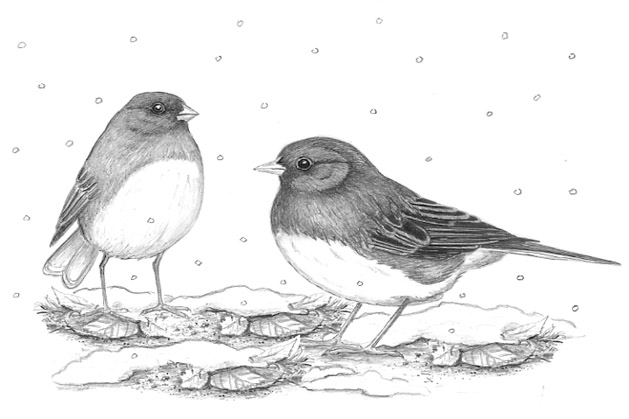
Dear Bird Folks,
This morning we woke up to an inch of snow on the ground, the first of the season. The snow also produced the first juncos of the season. I know they breed up in Canada, but how come we never see these “snowbirds” until the snow flies? And how did they get here so quickly? Did they take the “Montreal Express”?
– Jack, N. Eastham, MA
I doubt it, Jack,
I doubt your juncos took the Montreal Express. If they did, they probably wouldn’t be here yet. Actually, I don’t even know what the Montreal Express is but if it’s anything like what I’ve experienced with the Canadian mail system, those juncos would be lucky if they made it to your yard by July. In Canada, snail mail is not just a catch phrase; it’s reality. Have you ever seen their weird postal codes? They have Qs and Js in the middle of the numbers. They have codes like: “Q9K 5F2.” What? Good luck with that. However, I have to give the Canadian Postal Service huge points for their North Pole postal code, which is: “H0H 0H0” (ho-ho-ho). Pretty cool. That more than makes up for the rest of it.
It is impressive how juncos seem to appear out of nowhere the moment we get the very first snow of the season. It’s as if they pop out of the ground like flowers do when rain falls in the desert or like nosey men who suddenly appear anytime someone lifts up the hood of a car. North America has two species of juncos. We have the relatively restricted Yellow-eyed Junco and the widespread Dark-eyed Junco. As their common names indicate, the major distinction between the two birds is their eye color. You won’t have to worry too much about seeing the juncos with yellow eyes in N. Eastham, Jack. Their U.S. range is limited to small pockets in Arizona and New Mexico. The birds most of us see have dark eyes and are the ones called “snowbirds.” Dark-eyed Juncos can be found in just about any part of North America. The only area you aren’t likely to find these birds is in Florida, where they are replaced by another kind of snowbird. This other type of snowbird is typically found driving an RV on Rt. 1, clogging traffic, while traveling at a speed that is even slower than the Canadian mail.
Dark-eyed Juncos are extremely common birds. With a population that exceeds 600 million, they are very good at breeding, which probably explains why they have such dark eyes. Yet, the majority of us don’t see juncos during their breeding season. In the summer they are off nesting in more isolated locations, feeding on arthropods and other buggy things. After raising a brood or two, juncos start thinking about the coming winter. Some migrants, believe it or not, start arriving in New England as early as mid-August. With plenty of insects to be had those early arriving birds don’t have any serious interest in our yards. As the fall continues, waves of these gray and white birds pour down from the North. With the onset of colder weather the birds switch from insects to seeds. This is where we come in.
Throughout the country Dark-eyed Juncos are consistently listed as one of the most common birds at winter feeders. Millions upon millions of them accept the handouts we provide, but I’m going to let you in on a little secret. Juncos aren’t particularly fond of our cooking. Don’t take it personally, but it’s true. Given a choice they would much rather eat the seeds of wild grasses and weeds. The problem for the juncos is that during the winter, weeds and grasses are often covered with snow. When that happens the juncos seek alternative food sources. Snowfall doesn’t mysteriously produce juncos, but it does force them to go to Plan B, which is often our backyards.
For the most part you won’t find juncos sitting on a perch and eating from a feeder, like finches or chickadees do. They are basically ground-feeding birds, although they will come to a tray or a platform feeder. And even though I never recommend anyone buy or use mixed birdseed, juncos are one of the birds that will actually eat it, or at least some of it.
Most books tell us that the Dark-eyed Junco is one of the most well known birds in the country, but I’m not sure I agree. Juncos are common, yes, but not necessarily well known. The average, or even below-average person can easily identify, say, a cardinal, robin, swan, or hummingbird, but I’d bet a junco would give them trouble. To test my theory I asked the company that was at my house this past Thanksgiving. I showed everyone a picture of a junco and not a single one knew what it was. My theory was correct. However, I’ll admit that these people weren’t the best birders in the world. In fact, I think the only bird most of them could identify was the turkey that the dining room table.
I hope you get to see a lot of juncos, Jack. They are cute birds. I also hope that the Canadian Postal Service has sense of humor because I was only kidding earlier. You know, ho, ho, ho.